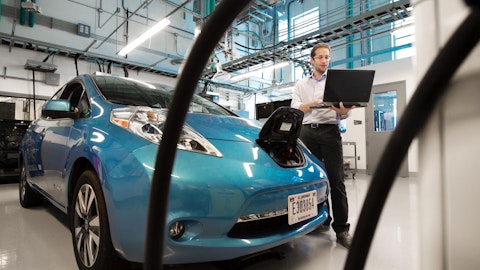Olga Shevorenkova: Correct.
Gabe Daoud: And then maybe just a follow-up. If I look at capital spend in €˜22, call it, $200 million or so, if you, I guess, kind of spend that again in €˜23, the $200 million relative to what’s on the balance sheet. Just how do we think about capital needs in funding that program this year? And are there any other forms of capital, whether it’s like a DOE loan program? Just are there any other levers that you can pull to fund the deployment this year? Thanks everyone.
Olga Shevorenkova: Yes. So as of now, where we stand with our cash balance today, we are signed for the duration of this year and most of next year. So, we do not — our growth plans are sized to be able to go through again the most of next year and, of course, this year. We remain opportunistic — capital raising opportunity presents itself, and we feel it’s the right thing to do. And we like how the markets look like, we will take that opportunity. So, that’s what I would say about the capital stretch. Regarding other sources of funds, as part of our G&A, we have the whole team focusing on looking at securing grant funds. So that is part of our strategy. And that some of it is baked into our forecast as well. And I don’t know, Cathy, if you have anything to add on that?
Cathy Zoi: Yes. I mean, I think, Gabe, you mentioned the DOE loan program, and that is certainly an exciting possibility. The timetables on that are, as you can probably imagine, very, very long. So that’s an interesting possibility, but it’s probably not a 2023 possibility for us or anybody for that matter, right? I mean, it’s just — it’s a long lead time.
Operator: We’ll take our next question from Maheep Mandloi with Credit Suisse.
Maheep Mandloi: Just following the previous question on — or maybe tackling the margins from a different angle here. In terms of OpEx, how should we think about that in the year here, like a similar run rate to Q4? I know in February, you talked about some structural changes of the Company, but just curious how to think about that going forward.
Olga Shevorenkova: Yes. Thanks, Maheep. So, we did go through some payroll efficiencies earlier this year. However, we still will be fulfilling certain positions, mostly in operations teams needed to help us close on execution of our pipeline and existing commitments. So, I would — Q4 is a fine proxy, but you’d see some movements throughout the year as the effect of efficiencies we introduced earlier this year come into play and as we continue to ramp up, probably not as significant as last year, but yes, there will be a ramp up on operations headcount, which you would also see throughout this year as well.
Maheep Mandloi: Got it. And on this domestic content question earlier. How early do you think the suppliers can move into the U.S.? Have they given you a time line yet, predominantly Delta, or PFJ?
Cathy Zoi: So, we have two major suppliers for our fast chargers both Delta and Signet. And they both have domestic production facilities under construction right now and are aiming for the latter part of this year to have those go on line. And once they go on line, we need to obviously test the equipment that comes out because for us, safety and reliability is of utmost importance. So, we like we’re hopeful end of this year that we’ll be able to sort of get access to those U.S. manufactured 350 chargers, 350-kilowatt chargers and get them moving. But that’s why you see the variability in our revenue range there.
Maheep Mandloi: Got it. And then just one last housekeeping, I’m sorry if I missed this. Did you talk about CapEx needs for this year?
Olga Shevorenkova: We don’t explicitly guide to the CapEx, but we do guide to total stalls in operation on the construction as of year-end, and you can infer from there.




